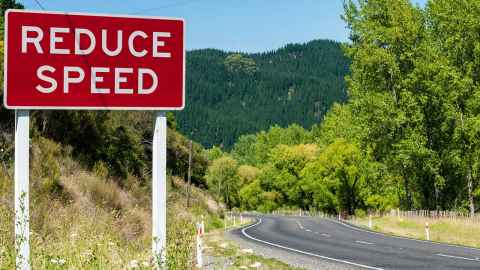Four speeding myths debunked
10 June 2019
Opinion: Dr Kirsty Wild and Professor Alistair Woodward from FMHS pick out and dismantle four flimsy arguments against reducing speed limits on dangerous roads.

Road crash injury is a significant problem in New Zealand; slower speeds will reduce the frequency of these crashes, particularly those that lead to severe injuries, and other countries have shown the way.
For example, the introduction of 20mph reduced speed zones in London led to a 40 percent reduction in serious injuries in the slow speed areas. And there was no sign of risks being transferred to other parts of the city as a result of displaced traffic and impatient drivers.
We therefore applaud the Government’s move to reduce speed limits on the country’s most dangerous roads. The fact is, despite claims to the contrary, speed management programmes are necessary and they are effective.
Here are four reasons commonly given for not introducing lower speed limits – and, we suggest, none withstand close attention:
Speed isn’t the main cause of road crashes
Those opposing speed restrictions might point to pedestrian crashes that result from jay-walking or not paying attention, or to collisions between cars with intoxicated drivers. But speed always plays a part because reaction times and braking distances depend on how fast the vehicle is travelling. And if there is a collision, the severity of injuries is a product of the velocity of the striking object and its mass. This is basic physics. Also, there is a faulty view of cause and effect in this argument. Just because factor X is a cause, doesn’t mean that factor Y is not important. Cigarettes are not the only cause of lung cancer – does that mean we should abandon efforts to make New Zealand smoke-free? No, of course not. Lack of attention is one cause of a crash, but it makes a big difference to survival prospects whether, when distracted, you encounter a fast-moving truck or a slow-moving bicycle.
Crashes and injuries are not really increasing
The Auckland Transport case for lower speeds emphasises the 78 percent increase in road deaths between 2014 and 2017. But in 2018 there were fewer casualties in Auckland than in 2017. And there has been a long-term decline in deaths on the road since the peak of the epidemic in the early 1970s. Does this mean there is no cause for alarm? Sure, there is year on year variability, just as there is with any big picture statistic, for instance, the number of people passing through Auckland Airport. So it doesn’t tell us a great deal comparing just two years. But while there has been a long-term improvement in road safety, this positive trend has been interrupted in the last five years. After decades during which the road toll steadily declined, the numbers have started going in the opposite direction. Here is good reason to review what is being done in Auckland to keep people safe on the road.
Crash injuries don’t happen on my street, why should slower speeds apply here?
There are variations on this argument. One could look at the CBD only, or certain streets in the CBD, and ask the same question. But small numbers of events may hide serious increases in risk – for example the streets in the CBD make up only 0.6 percent of the total city network, but account for 4 percent of all deaths and injuries.
And perhaps more importantly, AT is making policy for the city as a whole. In the first instance, the speed reductions are partial, applying to some stretches of the network and not others. But the fundamental question is – what needs to be done to protect the whole population of Auckland? The analogy might be the shop keeper who says “none of my customers have lung cancer, why should there be limits on selling cigarettes in my shop?”
It has been tried before and it didn’t work
In fact there are many examples of successful interventions to reduce speeds. London is one example we have mentioned already. In 2016 Christchurch introduced a 30kph zone in a large part of the city centre – injury crashes in the following two years fell by a quarter, while they increased 13 percent in the remainder of the CBD, which was in line with national trends. The 55 miles per hour speed limit introduced in the United States in the 1970s saved thousands of deaths each year from road crash injuries, due to slower speeds and more uniform pace of travel.
New Zealand’s road toll is worse than that of other developed countries we like to compare ourselves with, like the UK, Australia, Canada, France and Japan. And the statistics don’t tell the full story of loss and tragedy for families all over NZ. People worry that lower speeds will make already difficult trips longer and more stressful. In fact the increase in travel times is generally much less than feared, and slower less variable speeds make driving less difficult. And most important, speed is so often the difference between minor or life-changing injury, or life and death.
Professor Alistair Woodward and Dr Kirsty Wild are from the School of Population Health in the Faculty of Medical and Health Sciences.
This article reflects the opinion of the authors and not necessarily the views of the University of Auckland.
Used with permission from Newsroom Four speeding myths debunked published on 10 June 2019.